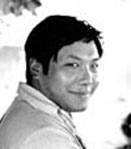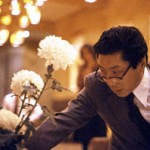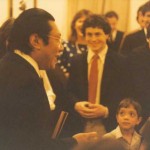Friday
Arts and Poetry, Community Articles“How do you put the soap back in the dish?” and other short stories by Herb Elsky

At a Los Angeles Dharma Art seminar 1980 Trungpa Rinpoche presented teachings about the connection between art and meditation practice.
After the talk there was the question and answer period. One woman raised her hand and said that she was a computer programmer but that what she really wanted to do was to be a full time ikebana practitioner. She went on and on for what seemed like a long time repeating her frustration with her work and expressing how much she wanted to do flower arranging. When she finally stopped there was a long pause and Rinpoche looked at her and said, “How do you put the soap back in the dish?”
He definitely stopped her mind, as he was implying with this comment that you can create arrangements at any time, with whatever is at hand.

At that time we were presenting a major ikebana installation at the Los Angeles Institute of Contemporary Art, which is documented in the film, “Discovering Elegance”.
The night before the show was supposed to open everything was running late. We were waiting for the seamstress to finish sewing many yards of red satin to cover the walls of the “Warriors Weapons” room. I was exhausted after two weeks of construction and preparations in the gallery space and here it was about three in the morning and we still had a lot to complete before the opening the next day. Finally the satin arrived and it was up to me to get it installed. I looked at the huge pile of folded satin, and then at the walls and I wondered if this was humanly possible to accomplish.
Suddenly I heard an encouraging voice in my mind from an unknown source that said, “Keep going”. I looked up and paused and then turned to see that Trungpa Rinpoche had snuck up behind me and whispered in my ear seemingly having read my mind. I can’t tell you how many times those words have come to mind when I have been faced with difficult situations.
In the early years whenever it was possible I would try to have a personal interview with Trungpa Rinpoche to show him pictures of what I was working on. When I first met him I was making transparent sculptures of polyester resin but at that time I was strictly macrobiotic and I could not resolve the conumdrum of eating to purify myself as a spiritual person and working with a toxic material.
A year earlier I had offered him a polyester prism sculpture that he liked very much. I wanted to change materials and I began doing large, thickly textured paintings and wall reliefs which seemed more natural. I showed him the pictures of the new work and he was silent for a while and then he said,” You should return to the clear”, meaning, the resin!
I said, “But it is toxic, expensive, and difficult to work with.” He had a way of looking over the top of his glasses that said more than words. He did not say anything but the message was evident. He had given his advice and it was up to me to figure out how to make it work.
He then said, “The setting sun artist jumps from one thing to another. The Great Eastern Sun artist takes one thing to great depth.”
So for the next twenty five years I developed my resin sculptures. I went through the most difficult resistance and then the whole process opened up for me. I bought the necessary equipment to protect myself and I began inventing new casting techniques and a process for assembling pieces together which created the possibility to develop more complex themes. I exhibited this work regularly in Los Angeles and galleries in other cities and many of these sculptures are in public and private collections in America.
In 1973 during a teaching tour he was visiting Los Angeles and stayed in our apartment. I showed him some sculptures that I had made and told him that I would like to offer him one. To my surprise there was one that he liked a lot and he said that he would like to have it when he had his own house.
A few years later I had an exhibition and that piece was in the show. Since it was in the show there was the chance that it could sell. I saw him at a seminar in northern California and I asked him if he would rather have the sculpture or the money.
He thought for a moment and then said, “Money is only money, but sculpture is sculpture!”







May 17, 2009
Reply
Great story. I was there for all, but the night before the opening having fallen ill, and its so great to hear different peoples stories of the same events you experienced. There was always so much more going on than any of us ever imagined at the time. I remember that sometimes people would ask Rinpoche a question at a talk and his answer would seem to make absolutely no sense to a number of us there. We would think that maybe he didn’t hear the question properly. However, when we would talk to the person who asked the question about the answer they received, to them it was spot on. It was like a private conversation in the midst of hundreds.
May 2, 2009
Reply
Whoops, let’s delete that last comment as I see I already mentioned it and clicked twice and here it is again. I never knew I stuttered. Amazing. No soap. Radio. Had a similar experience when this week tried to sell an Anni Albers print I own and a dealer told me, actually two dealers (we are experienced double-ness here) mentioned that it is much better to have the art than the money. One of them recounted a personal story of owning two Anish Kapoor prints that she would wake up every morning and see until she sold them for ‘a very good price.’ But now she can’t wake up and see these wonderful prints anymore. I am keeping my Anni Albers print. It has a lovely blue background and is filled with small grey triangles in a light grey and medium grey, some face downward and some upward. It is called ‘A’. Sometimes it manifests as a flight of birds and sometimes clouds, or flowing water.
May 2, 2009
Reply
What is referred to here as the ‘Warrior Weapon ” Room is actually called The Drum Room.
May 1, 2009
Reply
Thank you, Herb, for this wonderful story.
Love,
Anne
Apr 5, 2009
Reply
Just read Herb’s Soap Dish story and he mentions the “Warrior’s Weapons” room. Perhaps he is indicating the various rooms in the dharma art exhibitions that relate to the mandala of a house. I believe this last room, with red satin walls, might have been called The Drum Room. I do not recall a Warrior Weapon room. The drum would be the so-called weapon.
Apr 5, 2009
Reply
Just read Herb’s Soap Dish story and he mentions the “Warrior’s Weapons” room. Perhaps he is indicated the various rooms in the dharma art exhibitions that relate to the mandala of a house. I believe this last room, with red satin walls, might have been called The Drum Room. I do not recall a Warrior Weapon room. The drum would be the so-called weapon.